Makki ki roti is a popular and delicious Punjabi flatbread made using maize flour or yellow cornmeal. This 3 ingredient flatbread is inherently gluten-free, and can also be made vegan with slight modifications.
This Indian-style cornmeal bread is a winter staple and makes a perfect comfy winter meal when paired with Sarson ka saag, a dollop of butter (makkhan), jaggery, and buttermilk — all in all, ultimate comfort food.
Briefly heating spices unlocks fat-soluble aromatics. This deepens flavor in dals, curries, and sauces.
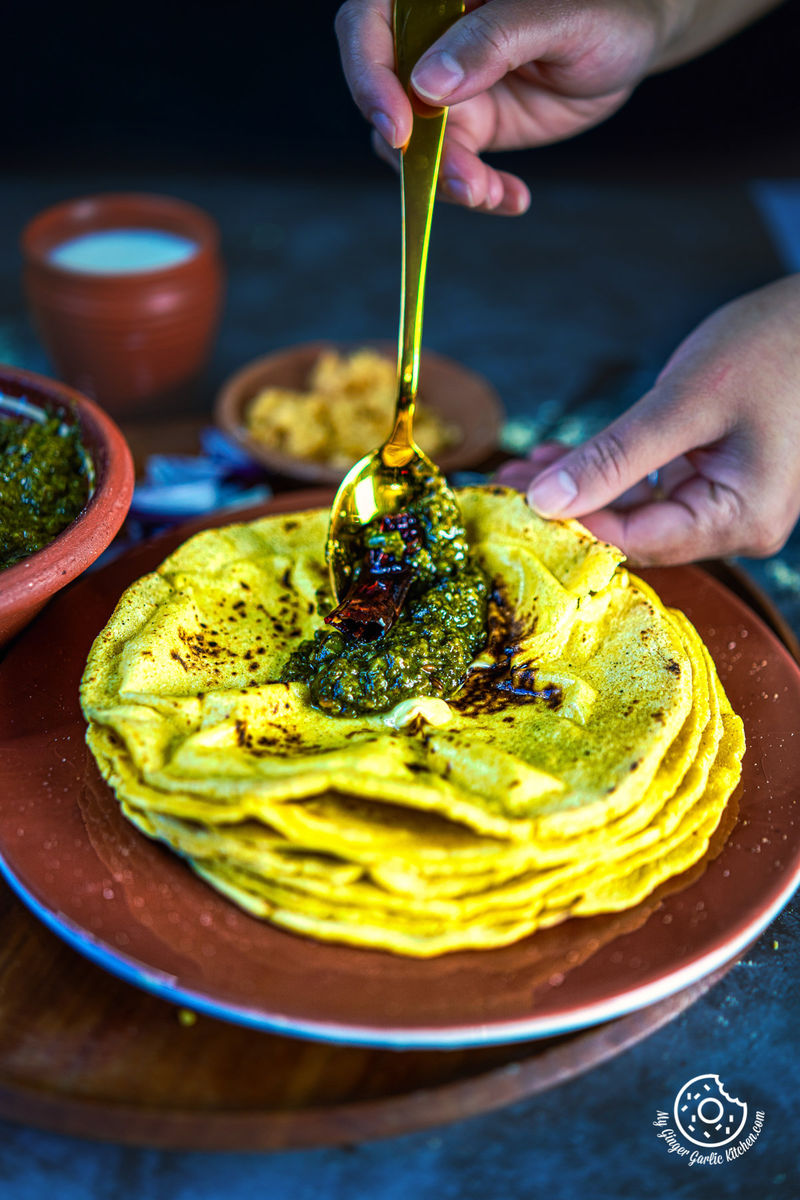
Table of contents
Made with extremely simple ingredients, this amazingly delicious, and flavorful homemade Makki Di Roti (in the Punjabi language) tastes amazingly delicious. It is a simple and easy-to-follow recipe which gets ready in under 30 minutes from start to finish.
So are you ready to relish this scrumptious makki ki roti with your friends and family?
About Makki Ki Roti
Punjabi Makki ki Roti or Maize flour flatbread is a must in North Indian homes, especially during winters. This is because it is served piping hot (straight from the pan) and tastes so good with leafy greens, and there is an abundance of seasonal leafy greens in the winter.
Makki ki Roti is one of the traditional Punjabi recipes that pairs best with Sarson ka Saag accompaniment.
Makki ki Roti with Sarson ka Saag is a nutrient-rich dish. Including these healthy nutrients in your winter diet boosts immunity and keeps your body warm during harsh winter months.
This roti is my childhood favorite. I can still revisit my memory lane and see my grandmother and mom making this roti on cool winter evenings or for the weekend lunches.
Back then I enjoyed this makki ki roti and sarson ka saag, but I loved it most when my mom used to put lots of white butter (makkhan) and chopped jaggery on hot roti. Then, she used to slightly crush the hot roti, and it became the world’s best dessert — lip-smacking good!
Now as a grown-up, whenever I feel nostalgic, I make that jaggery and butter topped roti (especially during winter months) to pamper myself and my little one, and she loves it as much as I do.
In North India, makki ki roti, bajra roti, jau ki roti, jowar roti are staples during the winter months. Other than this roti, my other winter favorites are gajar halwa, moong dal halwa, etc.
Makki ki Roti or Indian corn flour bread is traditionally served with sarson ka saag (leafy greens) in the Punjab region, but in Rajasthan, it is also served with, pyaaz ka besan, besan gatta, or panchmel dal.
Punjabi makki di roti is always prepared with yellow cornmeal. However, in Rajasthan this roti is prepared with both yellow and white cornmeal. To me, they both taste amazing.
If you love Indian flatbreads, then this healthy and delightful makki ki roti (Indian cornmeal bread) recipe is just calling your name.
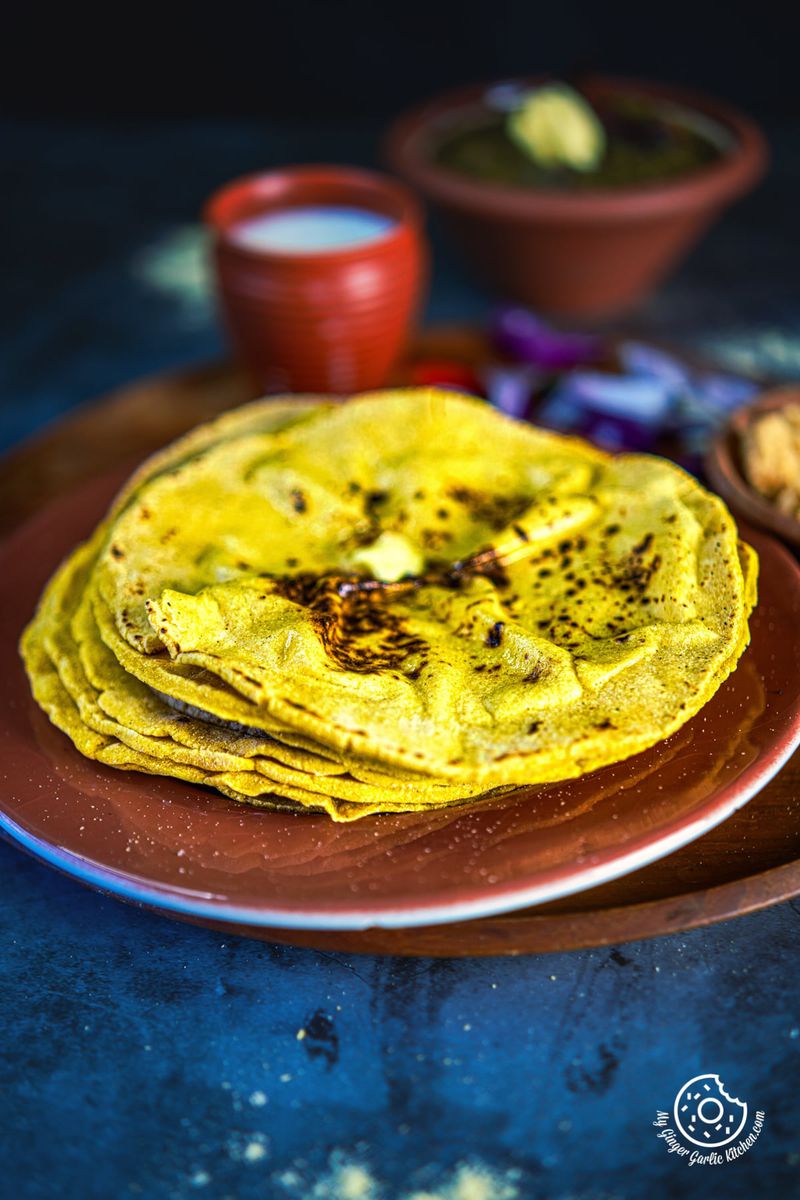
This Makki Ki Roti
✔ is a gluten-free indian bread
✔ can also be made vegan
✔ is straightforward and easy to make
✔ has the perfect texture and taste
✔ is wholesome and nutritious
✔ needs only a few simple ingredients
Love Punjabi recipes? Then you should check out these popular Punjabi dishes such as; Dal Makhani, Punjabi Achaari Gobi, Punjabi Chole, Amritsari Chole, Amritsari Aloo kulcha, and Punjabi Rajma Masala.
What is Makki Ki Roti?
Makki Ki Roti Or Makki Di Roti is a popular flatbread from Punjab which is made with makki ka atta (maize flour). In homes, it is cooked on a tawa (flat pan), and in restaurants sometimes they also cook it in a tandoor (clay oven).
This roti is flawlessly crisp on the outside and cushiony soft on the inside.
It is a gluten-free unleavened bread that is typically served with sarson ka saag (winter leafy green curry), butter and jaggery, and this delicious combination makes a comfy meal.
Makki ki roti is prepared with yellow cornmeal that is made with dried yellow corn which is a rich source of vitamin A, C, K, and zinc.
During the winter months, you get an endless variety of greens, and adding greens to your winter diet adds vital antioxidants, and that’s why it is made and enjoyed during winter.
This roti can be served as a healthy, delicious, and comfy lunch, satisfying dinner. You can even serve it as a breakfast along with a dollop of butter and a cup of hot masala chai.
In this recipe ‘makki ki roti’, ‘Makki’ means Maize and Roti is a name for flatbread or unleavened. So the literal translation of makki ki roti is a flatbread made with yellow cornmeal.
Cornflour is also known as cornstarch in many countries, so please note that you are using ground cornmeal, and not cornstarch.
Just like gajar matar ki sabzi, aloo ka paratha, methi malai matar, and aate ki pinni, this makki ki roti is a quintessential Punjabi winter food that is enjoyed in every North Indian household in winters.
Generally, makki ki roti doesn’t need any recipe, you just need to mix the flour with salt and water to make the dough. I always thought making Makki ki roti was super easy, because it was so easy for my Mom.
However, when I made this roti myself as a grown-up for the first time, it wasn’t as easy as it seemed. It was tricky to roll and properly cook the rotis.
Rolling them without breaking them was a task in itself. It was tough to roll because this roti is made with makki ka atta which is a gluten-free flour and thus it is hard to roll.
But with practice, tips, tricks, and my Mom’s age-old wisdom, I am finally able to make really good and puffed-up makki ki roti.
On this page, I have tried to cover every point that is significant for making the perfect makki ki roti. So just follow the instructions carefully, and you would be able to make makki ki roti like a pro in no time.
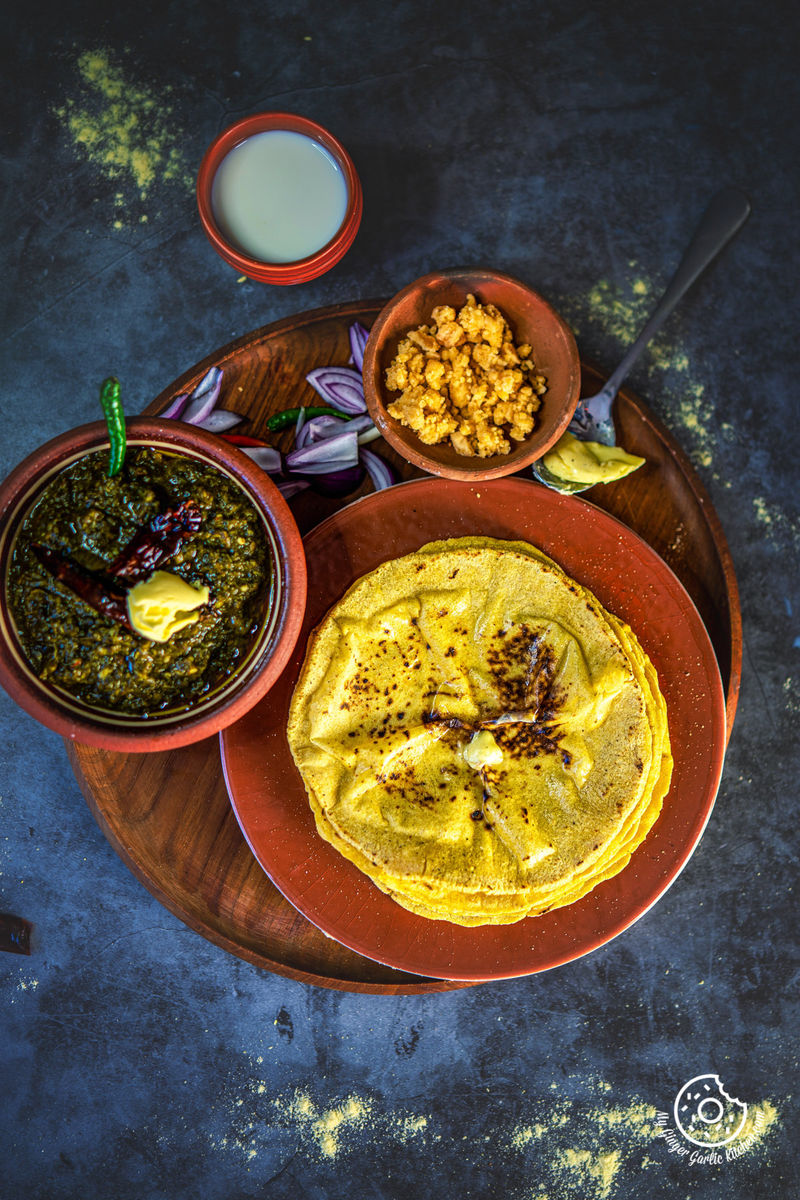
Makki Ki Roti Ingredients
This Cornmeal flatbread recipe also known as Makki ki roti is made with just 3 simple main ingredients. These ingredients are:
-
Cornflour (Cornmeal): It is one of the key ingredients of this recipe. It is also known as maize flour or Makki ka atta. When making makki ki rotis, always use fresh cornmeal to make the rotis.
-
Salt: Adding a little bit of salt to flour enhances the taste and flavor of this cornmeal bread. However, adding salt is completely optional here.
-
Butter/Ghee/Oil: It is used for smearing on rotis. You can use homemade white butter (makkhan), or store-bought unsalted butter. Ghee or coconut oil can also be used instead of butter.
-
Water: It is needed for making dough. You can either use regular water and boil it, or you can use the boiled water.
How to make Makki Ki Roti?
Making this roti can be tricky if you make it as a beginner. But it is fairly simple if you follow the instructions carefully. Here, I have shown two methods of rolling and two ways of cooking makki ki roti on this page, so you can choose any method which is comfortable for you.
This is how makki ki roti can be made in 10 simple steps:
Step 1: Add water and salt to a pan and stir. Cover the pan and let it come to a boil.
Step 2: Once the water comes to a boil, turn the heat to low and add the cornflour.
Step 3: Mix using a spatula until the liquid is fully incorporated and the mixture comes together like a dough.
Step 4: Now turn off the heat and drizzle with 1 tablespoon of water. Cover the pan with the lid and set aside for 15 minutes or until it is warm.
Step 5: Transfer cornmeal mixture to a large plate and knead the dough with the heel of your palm until it is soft and pliable. Kneading well is very important here to get soft rotis.
Step 6: Divide the dough into equal portions and roll each portion into a ball.
Step 7: Dust the dough ball with dry flour and roll it into a 6-7 inches circle using a rolling pin or pat with hands to spread. Alternatively, you can roll it on parchment paper. First, grease the dough ball and parchment paper and flatten the ball slightly with your palm.
Step 8: Then place the dough ball on the paper. Now pat it in a circular motion to spread or, or fold the parchment paper over the dough ball and just roll it with a rolling pin. Lift the rolled roti and transfer it onto your palm.
Step 9: Heat a flat pan/tawa and place the rolled roti on it. Cook the roti from one side until you see the bubbles on the surface, then flip the roti on the other side, and press it down with a spatula. This pressing would help roti to puff.
You can also place the roti directly on the flame, and cook until it is puffed and charred.
Step 10: Apply butter or ghee on hot roti and serve them with sarson ka saag.
For a fully step-by-step picture and detailed video recipe, follow the instructions and video recipe shared in the recipe box on this page.
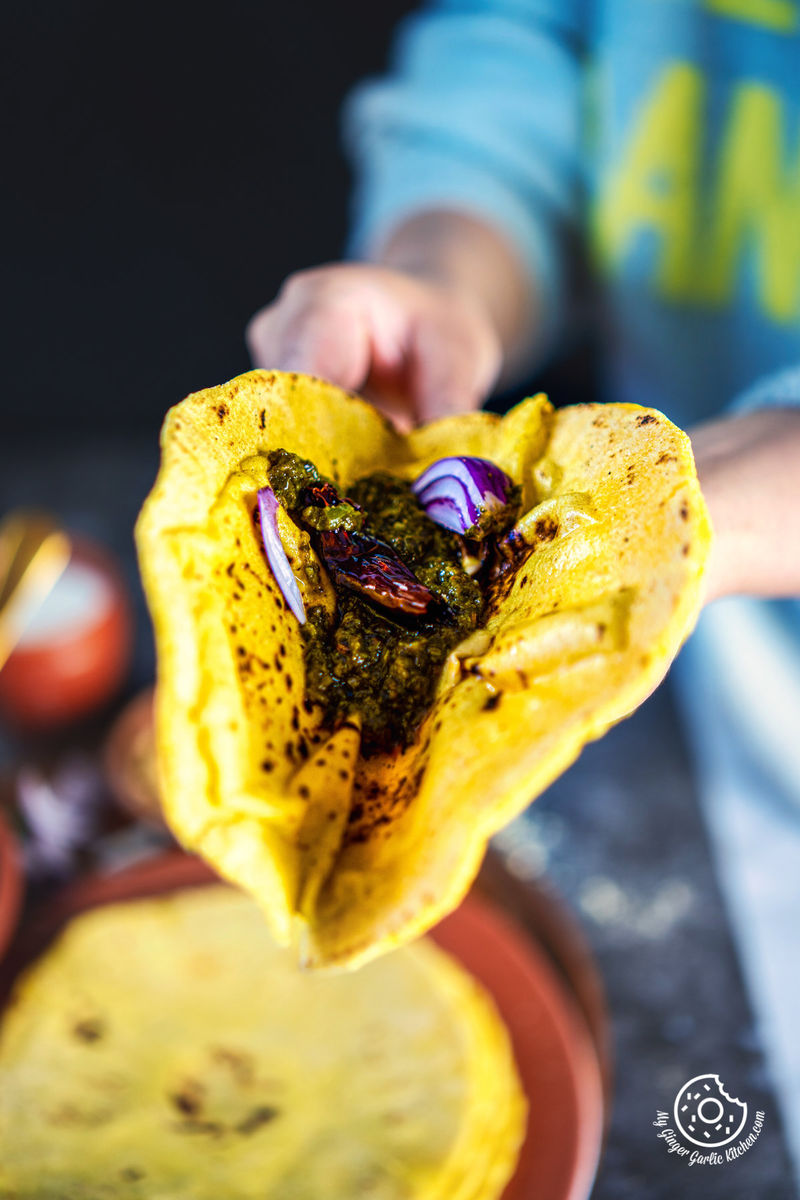
Variations:
This roti tastes best as it is without any added ingredients. But this is also a versatile recipe where you can add many nutrient-rich ingredients. You can make it more nutritious by adding:
-
Some freshly chopped leafy greens such as radish greens (mooli ke patte), fenugreek leaves (methi), spinach leaves (palak), or goosefoot leaves (bathua).
-
Radish: For added nourishment, you can also add grated radish or mooli to the flour mixture while making the dough. You can also use a combination of leafy greens and radish to make makki ki roti or makki ka paratha
-
Carom seeds: For some people, this roti is a bit heavy to digest, so if you have a digestion issue then add 1 teaspoon of crushed carom seeds (ajwain) to the dough. The addition of carom seeds definitely helps with digestion.
-
Dried fenugreek leaves: Kasuri methi or dried fenugreek leaves can also be added to the dough.
Storage
Makki ki rotis stay fresh for up to 2 days when stored wrapped in kitchen tissues. You can store the cooled roti in an air-tight container or in a ziplock bag.
Tips & tricks to make the best Makki Ki Roti
-
Cooking: Make sure to cook the makki ki rotis properly. Or else you might upset your tummy.
-
Knead each dough ball for a few seconds before rolling it into a roti. Kneading before rolling yields the softer roti.
-
Wheat Flour: If you find it really difficult to roll the rotis, then you can add 2-3 tablespoons of wheat flour to the dough. Gluten in wheat flour would make dough pliable and easier to roll.
-
Make small rotis: If you are a beginner, then I would suggest you make small rotis at first because they are easier to roll and handle. When you get a hang of it, then you can always roll it in the preferred size.
-
If for some reason the dough looks or feels dry while rolling, then you can add some warm water to the dough and knead well. If the dough feels sticky, then add 1-2 tablespoons of makki ka atta (maize flour).
-
Flour: This delicious roti is made with yellow-colored cornmeal (maize flour or makki ka atta). Cornflour in India is cornmeal, but in many countries, cornflour is known as cornstarch which is super fine white flour (used as a binder and thickening agent in many dishes). Makki ka atta is yellow-colored ground cornmeal or maize flour, so make sure that you use the right flour. Don’t use the coarse-textured flour, or it will be difficult to roll.
-
Keep the dough balls covered at all times and work with one ball at a time.
-
Rolling: Roll these rotis slightly thicker than chapati. This would prevent rotis from getting hard. If you can’t roll rotis on a rolling board, then you can shape the dough ball into a roti using parchment paper. Using parchment paper makes the rolling process super easy and non-sticking.
-
For making soft makki ki roti, knead the dough well with the heels of your palm; this would take about 3-5 minutes.
-
Hot water: Some people like to use regular or warm water for kneading the dough. I personally find that hot water gives the best result. Knead always with boiling hot water. This helps in making dough workable and easy to roll.
-
Storing: Stack the cooked makki ki roti in between clean towels. This would absorb the extra moisture from the rotis and would prevent them from sweating.
-
Heat: When cooking makki ki roti, keep the heat on medium. These rotis are slightly thick, so they get cooked well on medium heat.
-
Roasting: Instead of dry roasting, you can also apply ghee/oil while roasting. This would make makki ka paratha.
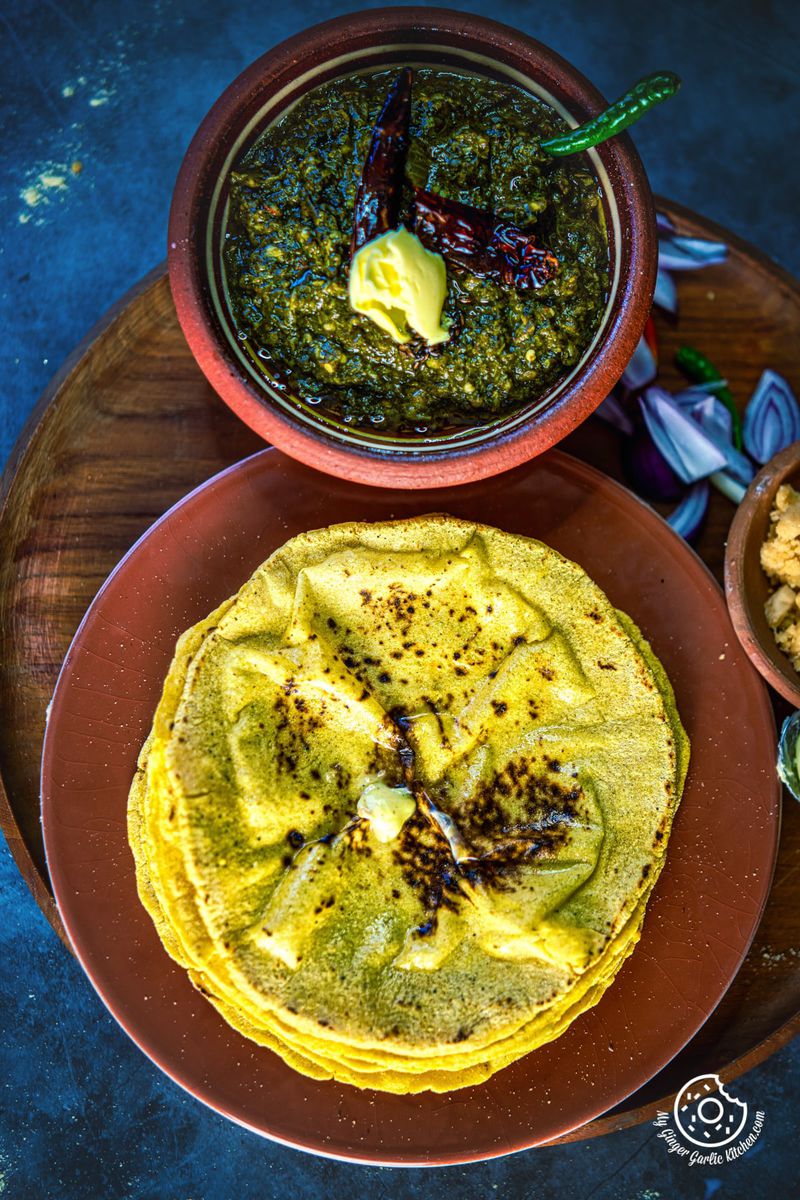
FAQ
Can I make this roti using a tortilla press?
I haven’t made myself this roti using a tortilla press, but I guess it would work. Place the dough ball between two plastic sheets or parchment papers and then press. It would be helpful for easy removal.
Can I make makki ki roti in advance?
Makki Ki Roti can surely be made 1-2 days in advance, but they taste best when they are served piping hot straight from the pan. However, you can surely store the cooked roti in the refrigerator for up to 2 days.
To store, wrap the cooled roti in a cling wrap first and then place them either in a ziplock bag or in an air-tight container.
You can make the dough in advance and store it wrapped in cling film first and then in an air-tight container. It can stay in a refrigerator for up to 2 days.
Can I freeze makki ki roti?
Yes, makki ki roti is freezable. Once cooked, let the rotis cool completely then stack them with parchment paper between each roti. After that, transfer the rotis in a ziplock bag and seal them by taking out as much air as possible. Then freeze.
They stay well for up to 2 months in the freezer.
When you want to serve, thaw the rotis at room temperature or thaw them overnight in the refrigerator. Then reheat them on a hot tawa/flat pan until heated through.
What to do if my makki ki roti is breaking when I roll them?
Rolling makki roti is slightly tough because the maize flour doesn’t have any gluten. If your rotis break while rolling, then roll them either between the greased parchment paper or plastic bag. You can also spread the roti by patting gently in a circular motion.
If you still find rolling too hard, then add some wheat flour to the dough. This will add some gluten to the dough and rotis will be easier to roll. When you add wheat flour, the rotis would taste slightly different.
Also, keep in mind that after adding wheat flour, rotis won’t remain gluten-free.
How to make Vegan Makki Ki Roti?
To make a vegan version of makki ki roti, you can swap ghee with coconut oil. Or you can also roast these rotis with some vegetable oil.
Can I reheat Makki Ki Roti?
Yes, you can definitely reheat the leftover makki ki roti. To reheat, place the roti on a skillet and roast with ghee. Or, place it directly on heat until roti is warm/hot.
You can also reheat this roti in a microwave. To microwave, wrap the rotis in damp kitchen tissue and heat for 30 seconds or until warm. Wrapping in a damp kitchen tissue helps the roti to stay soft after warming because microwaving won’t take away the moisture.
Makki Ki Roti (Step-by-step photo instructions)
Making dough
- In a saucepan add 1 cup + 3 tablespoons water, salt, and mix together. Cover the pan and let it come to a boil. Alternatively, you can also use boiling hot water.
- Once the water starts to boil, turn the heat to low and add makki ka atta. Using a spatula mix well to incorporate the hot water into the flour. At this point, you can add 1-2 tablespoons more water if the flour mixture looks dry.
- Once the mixture is mixed, drizzle it with 1 tablespoon of water and cover the pan with the lid. Leave it for 15 minutes or until the dough becomes warm.
- After 15 minutes the mixture is warm enough to touch. Now transfer the mixture onto a wide plate and start kneading the dough. Keep kneading until it forms a soft dough. The best way to knead this dough is by rubbing it with the heel of your palm, doing this would make the dough pliable. Make sure that the dough is soft. If at any point dough seems dry, then you can 1-2 tablespoons of water, or if the dough is sticky, then add a few tablespoons of maize flour. I knead the dough for 3-4 minutes or until smooth and pliable. The kneading time may vary depending upon the flour you are using.
- Divide the dough into equal portions and roll each portion to make a smooth ball. Keep all the dough balls covered.
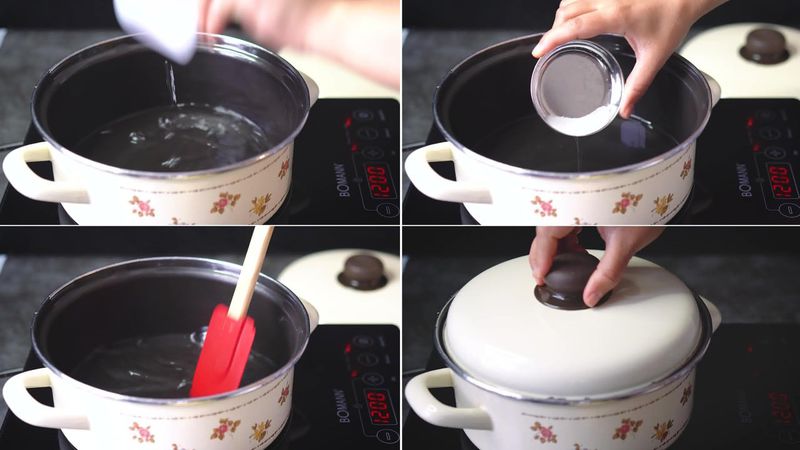
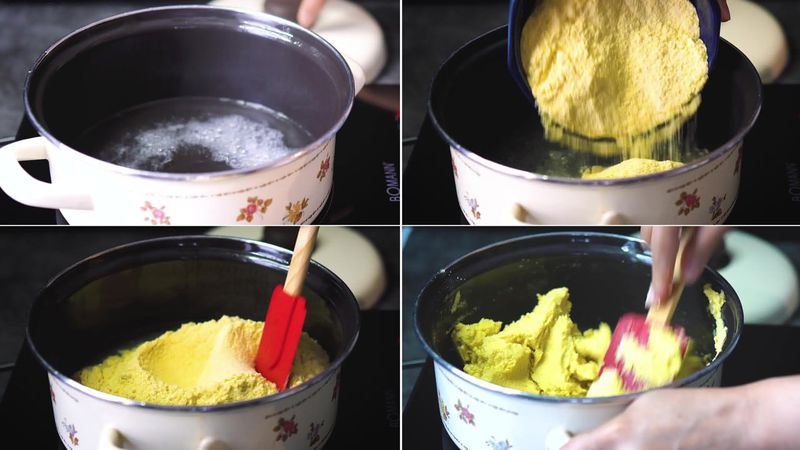
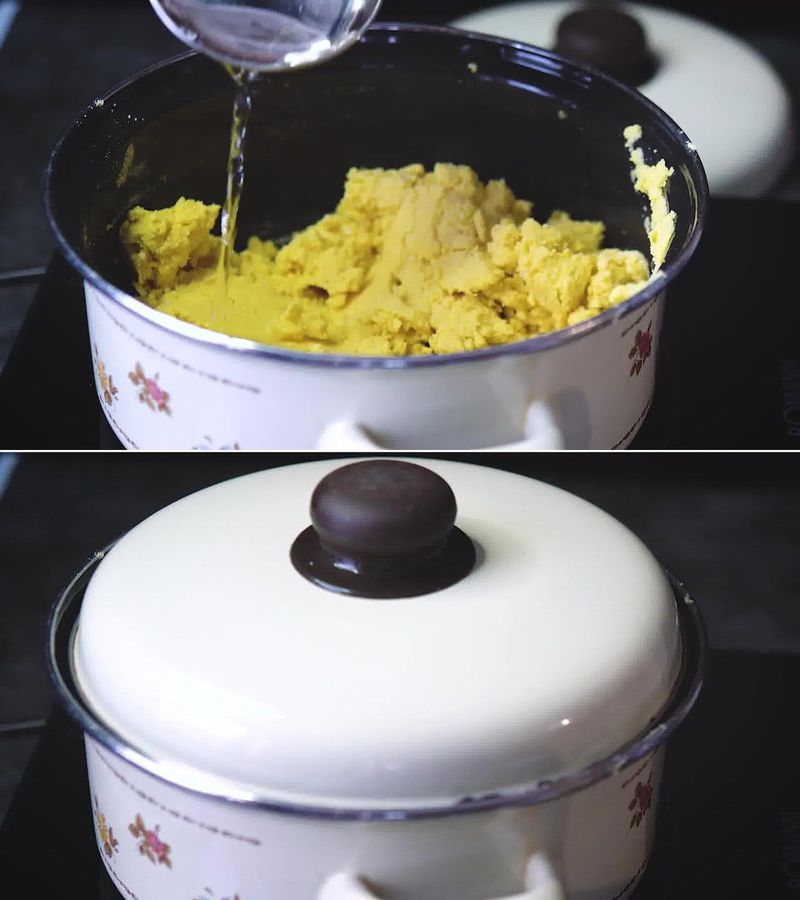

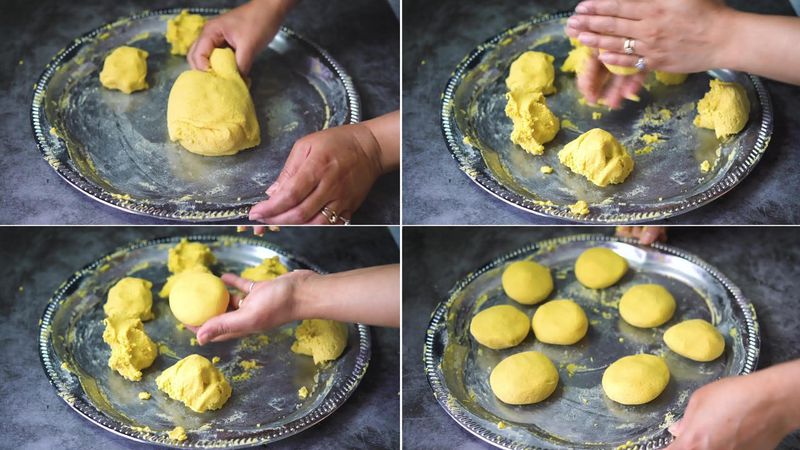
Rolling Method 1
- Now, take one dough ball and roll it into maize flour. Also, sprinkle some maize flour on the rolling board. Now roll the dough ball to flatten it between your palms by moving it in a circular motion. It should be approx 3 inches in diameter circle, about the size of your palm.
- Now, place the dough flattened circle on the rolling board and gently roll with a rolling pin into the circle of 6-7 inches diameter. Roll roti slightly thick, thin roti won't stay soft. After rolling, you may also fix the broken edges with the help of your palm. Also, make sure that all the sides of the roti are evenly rolled. Gently remove the roti from the rolling board carefully transfer the roti onto your palm. Roll all the rotis the same way until remaining all the dough is used up.
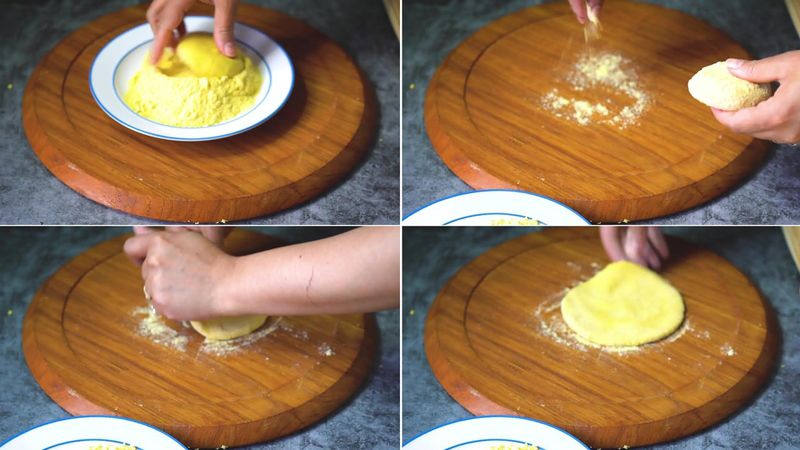
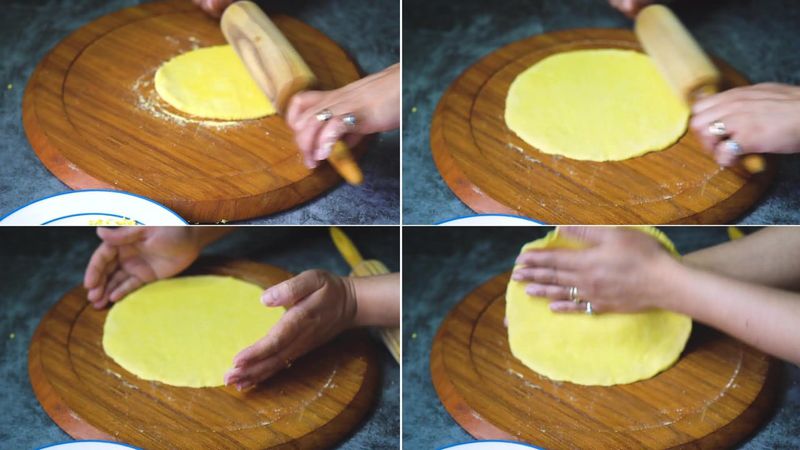
Rolling method 2
- Take a parchment paper/plastic sheet. Apply water or oil on your palms and flatten a dough ball between your palms. It should be approx 3 inches diameter circle. Now, grease the parchment paper.
- Then, place the flattened circle onto parchment paper, and spread the dough by patting in a circular motion. You need to roll the dough until it reaches a circle diameter of 6-7 inches. Alternatively, fold the parchment paper/plastic sheet over the dough ball. Flatten the dough ball with your hands or gently roll it with a rolling pin.
- Lift the parchment paper from the top of the roti and carefully transfer the roti onto your palm. You can also directly transfer it to the pan. Put the paper side up and then gently remove the paper.
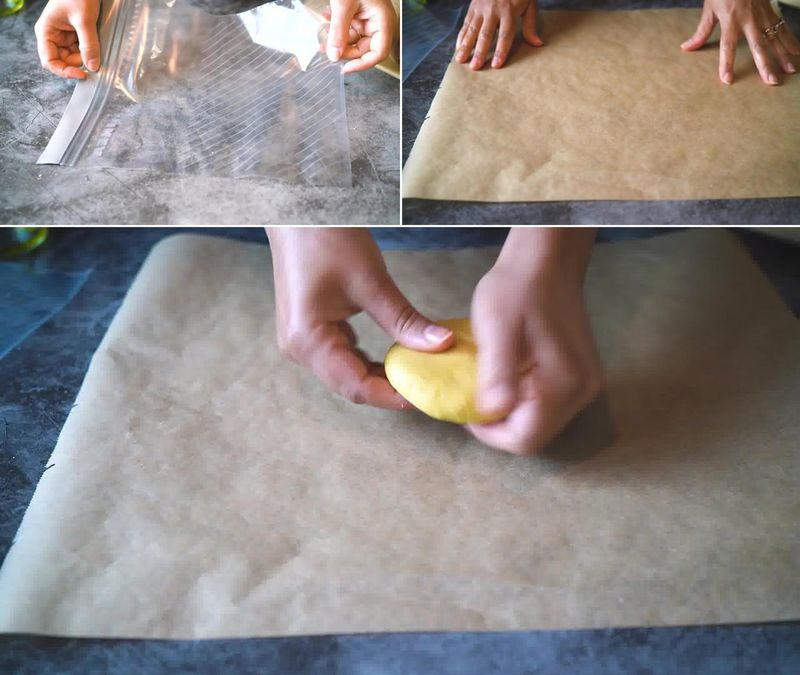
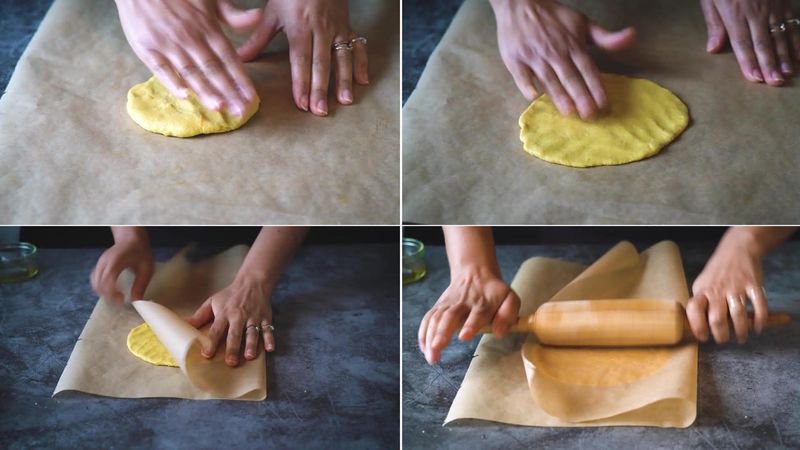
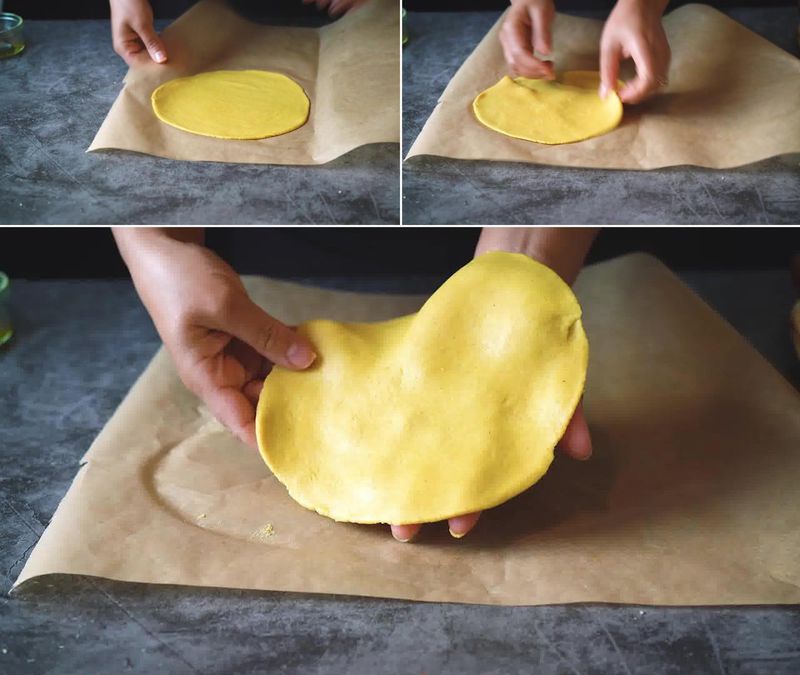
Cooking makki ki roti in a pan
- Heat a tawa/flatpan over medium heat and gently place the rolled roti on it. When you start to see the bubbles and the bottom side is browned, flip the roti with the help of a spatula. Cook for a few seconds until you see brown spots.
- Now lightly press down the roti with the back of a spatula. This pressing would help roti to puff up. At this point, your makki ki roti would start puffing up. Keep pressing lightly till the entire roti is puffed. Flip it and cook till from the other side too until the roti is browned and cooked from all the sides.
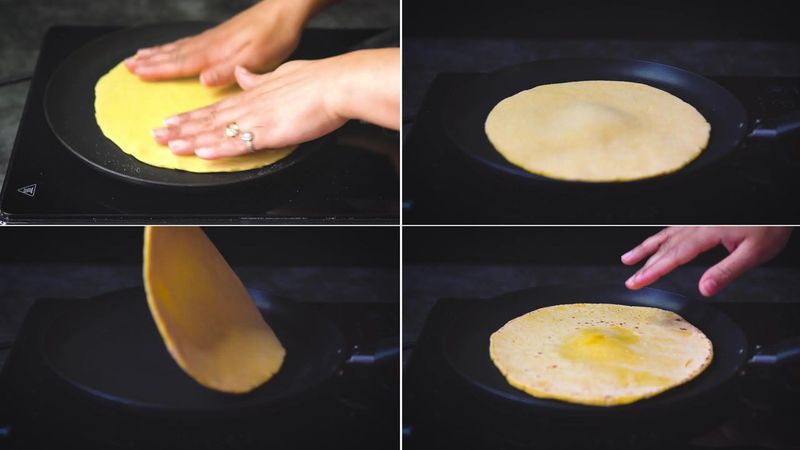
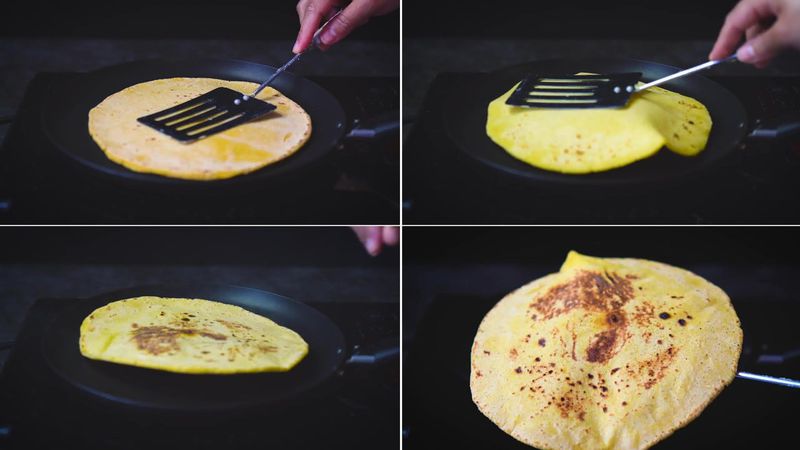
Cooking makki ki roti on the induction and electric stove:
- Heat a flatpan/tawa on medium heat. Now gently remove the roti from the rolling board and place the rolled roti on the hot pan. When you see bubbles forming up, flip the roti and cook on the other side for a few seconds or until you see brown spots.
- Put a roti jali on the induction or electric stove, and then place the roti directly on it. Gently press it with a spatula. At this point, you would start to see the roti puff up. Flip it and cook on the other side until it is charred.
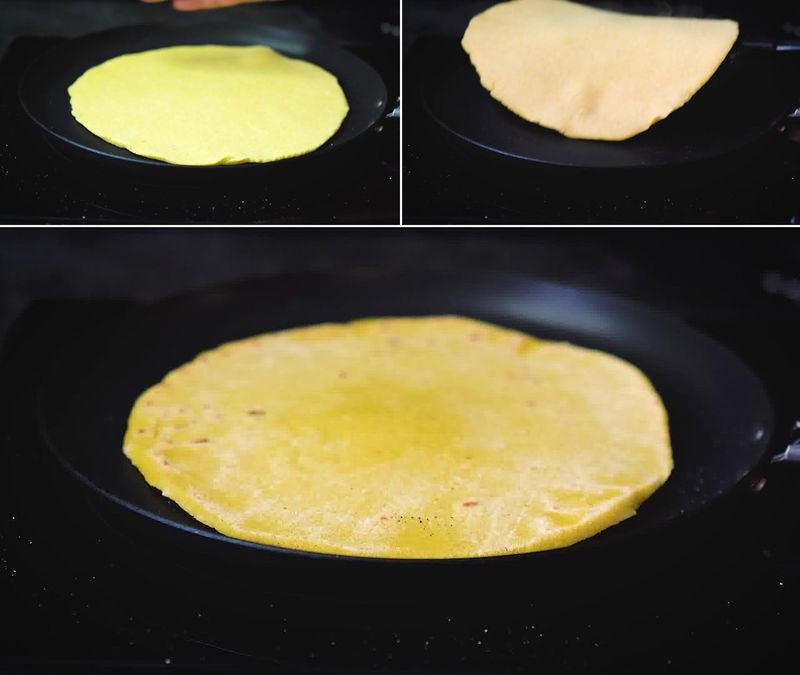
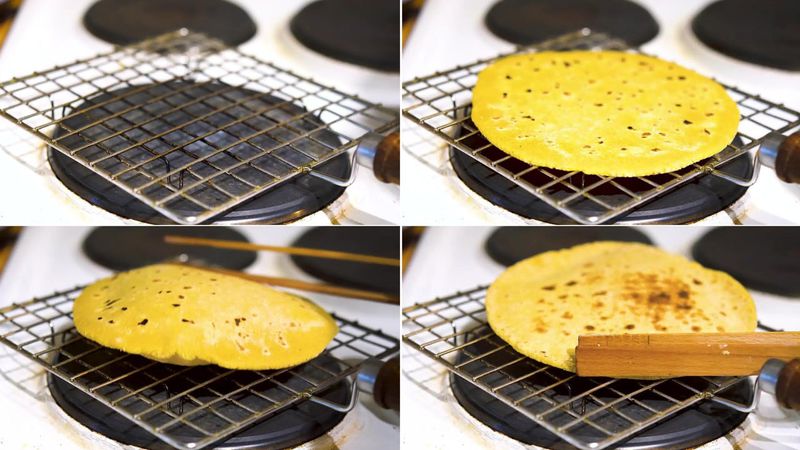
Serving:
- Pile the cooked rotis in a kitchen tissue-lined wooden basket. Then smear hot makki ki rotis with a dollop of butter (makkhan) or ghee. Serve the makki ki roti hot with Sarson ka Saag, jaggery and buttermilk.
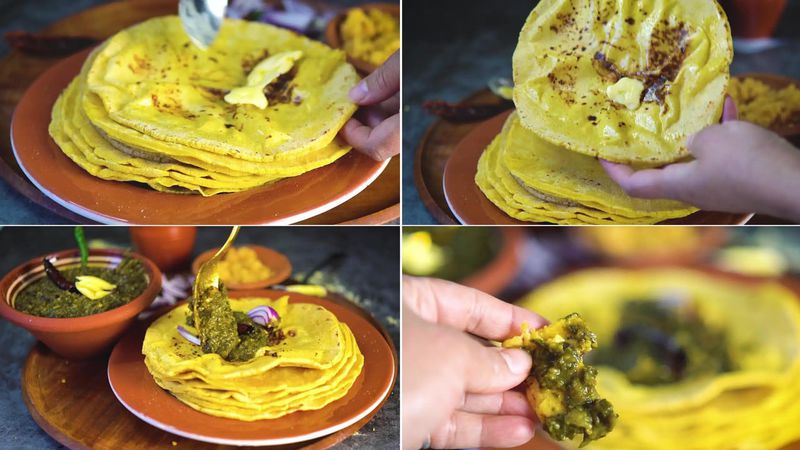
Recipe Card
Makki Ki Roti [Recipe]
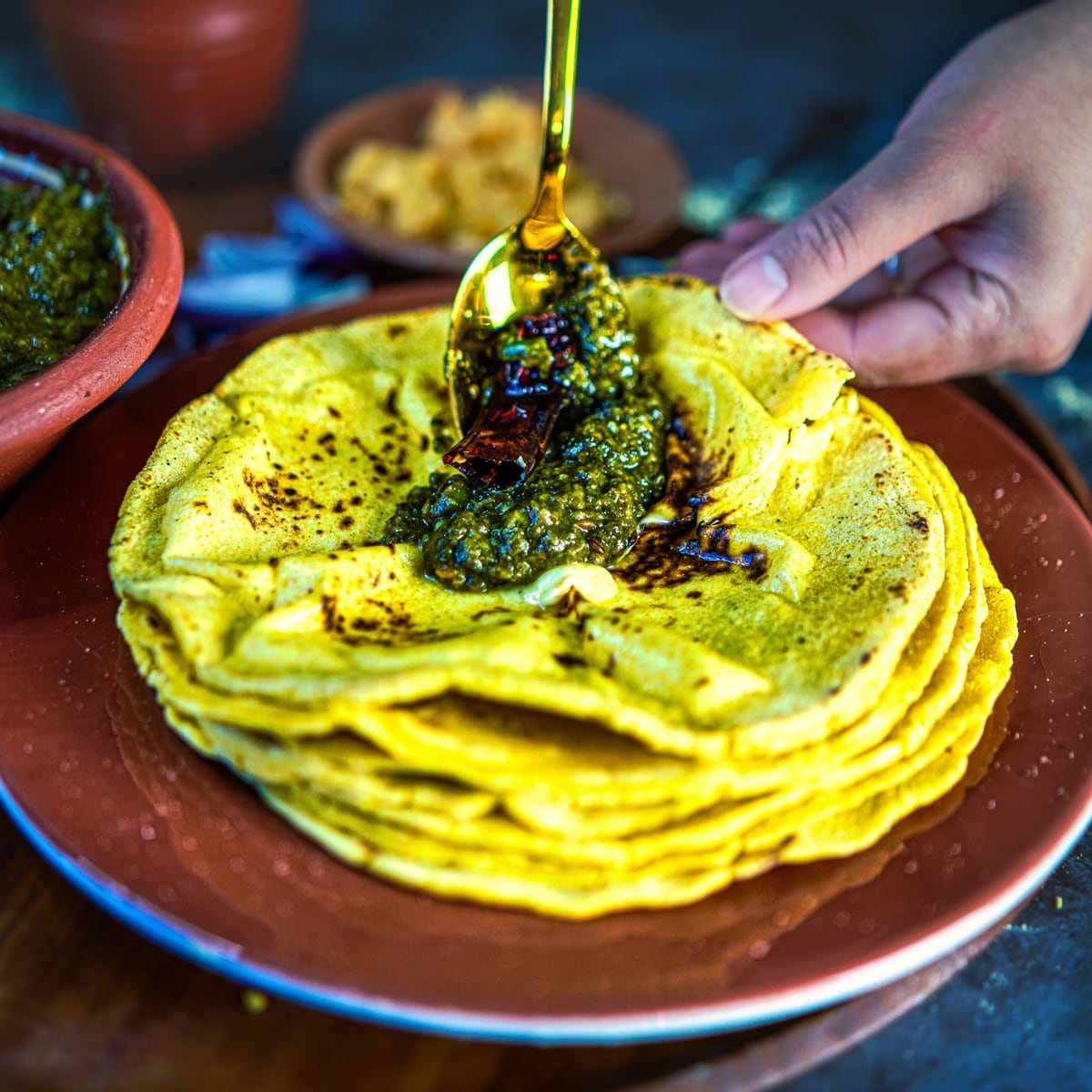
★★★★★
(Rating: 5 from 4 reviews)
| Prep time 🕐 | Cook time 🕐 | Total time 🕐 |
|---|---|---|
| 30 mins | ||
| Category ☶ | Cuisine ♨ | Serves ☺ |
| Breads | Indian | 8 |
| Nutrition Info ⊛ | Serving size ⊚ | |
| 184 calories | 1 roti |
INGREDIENTS
For Makki Ki Roti
- 2 cups makki ka atta (maize flour/corn flour), 250 grams
- 1/2 teaspoon salt, or to taste
- 5-6 tablespoons butter/ghee or add as required, for spreading
INSTRUCTIONS:
Making dough
- In a saucepan add 1 cup + 3 tablespoons water, salt, and mix together. Cover the pan and let it come to a boil. Alternatively, you can also use boiling hot water.
- Once the water starts to boil, turn the heat to low and add makki ka atta. Using a spatula mix well to incorporate the hot water into the flour. At this point, you can add 1-2 tablespoons more water if the flour mixture looks dry.
- Once the mixture is mixed, drizzle it with 1 tablespoon of water and cover the pan with the lid. Leave it for 15 minutes or until the dough becomes warm.
- After 15 minutes the mixture is warm enough to touch. Now transfer the mixture onto a wide plate and start kneading the dough. Keep kneading until it forms a soft dough. The best way to knead this dough is by rubbing it with the heel of your palm, doing this would make the dough pliable. Make sure that the dough is soft. If at any point dough seems dry, then you can 1-2 tablespoons of water, or if the dough is sticky, then add a few tablespoons of maize flour. I knead the dough for 3-4 minutes or until smooth and pliable. The kneading time may vary depending upon the flour you are using.
- Divide the dough into equal portions and roll each portion to make a smooth ball. Keep all the dough balls covered.
Rolling Method 1
- Now, take one dough ball and roll it into maize flour. Also, sprinkle some maize flour on the rolling board. Now roll the dough ball to flatten it between your palms by moving it in a circular motion. It should be approx 3 inches in diameter circle, about the size of your palm.
- Now, place the dough flattened circle on the rolling board and gently roll with a rolling pin into the circle of 6-7 inches diameter. Roll roti slightly thick, thin roti won't stay soft. After rolling, you may also fix the broken edges with the help of your palm. Also, make sure that all the sides of the roti are evenly rolled. Gently remove the roti from the rolling board carefully transfer the roti onto your palm. Roll all the rotis the same way until remaining all the dough is used up.
Rolling method 2
- Take a parchment paper/plastic sheet. Apply water or oil on your palms and flatten a dough ball between your palms. It should be approx 3 inches diameter circle. Now, grease the parchment paper.
- Then, place the flattened circle onto parchment paper, and spread the dough by patting in a circular motion. You need to roll the dough until it reaches a circle diameter of 6-7 inches. Alternatively, fold the parchment paper/plastic sheet over the dough ball. Flatten the dough ball with your hands or gently roll it with a rolling pin.
- Lift the parchment paper from the top of the roti and carefully transfer the roti onto your palm. You can also directly transfer it to the pan. Put the paper side up and then gently remove the paper.
Cooking makki ki roti in a pan
- Heat a tawa/flatpan over medium heat and gently place the rolled roti on it. When you start to see the bubbles and the bottom side is browned, flip the roti with the help of a spatula. Cook for a few seconds until you see brown spots.
- Now lightly press down the roti with the back of a spatula. This pressing would help roti to puff up. At this point, your makki ki roti would start puffing up. Keep pressing lightly till the entire roti is puffed. Flip it and cook till from the other side too until the roti is browned and cooked from all the sides.
Cooking makki ki roti on the induction and electric stove:
- Heat a flatpan/tawa on medium heat. Now gently remove the roti from the rolling board and place the rolled roti on the hot pan. When you see bubbles forming up, flip the roti and cook on the other side for a few seconds or until you see brown spots.
- Put a roti jali on the induction or electric stove, and then place the roti directly on it. Gently press it with a spatula. At this point, you would start to see the roti puff up. Flip it and cook on the other side until it is charred.
Serving:
- Pile the cooked rotis in a kitchen tissue-lined wooden basket. Then smear hot makki ki rotis with a dollop of butter (makkhan) or ghee. Serve the makki ki roti hot with Sarson ka Saag, jaggery and buttermilk.
Watch Full Recipe Video:
NOTES:
- Knead each dough ball for a few seconds before rolling it into a roti. Kneading before rolling yields the softer roti.
- Wheat Flour: If you find it really difficult to roll the rotis, then you can add 2-3 tablespoons of wheat flour to the dough. Gluten in wheat flour would make dough pliable and easier to roll.
- Make small rotis: If you are a beginner, then I would suggest you make small rotis at first because they are easier to roll and handle. When you get a hang of it, then you can always roll it in the preferred size.
- If for some reason the dough looks or feels dry while rolling, then you can add some warm water to the dough and knead well. If the dough feels sticky, then add 1-2 tablespoons of makki ka atta (maize flour).

Questions or comments about this recipe: